NBC Washington, Telemundo transforming historic Nebraska Avenue building
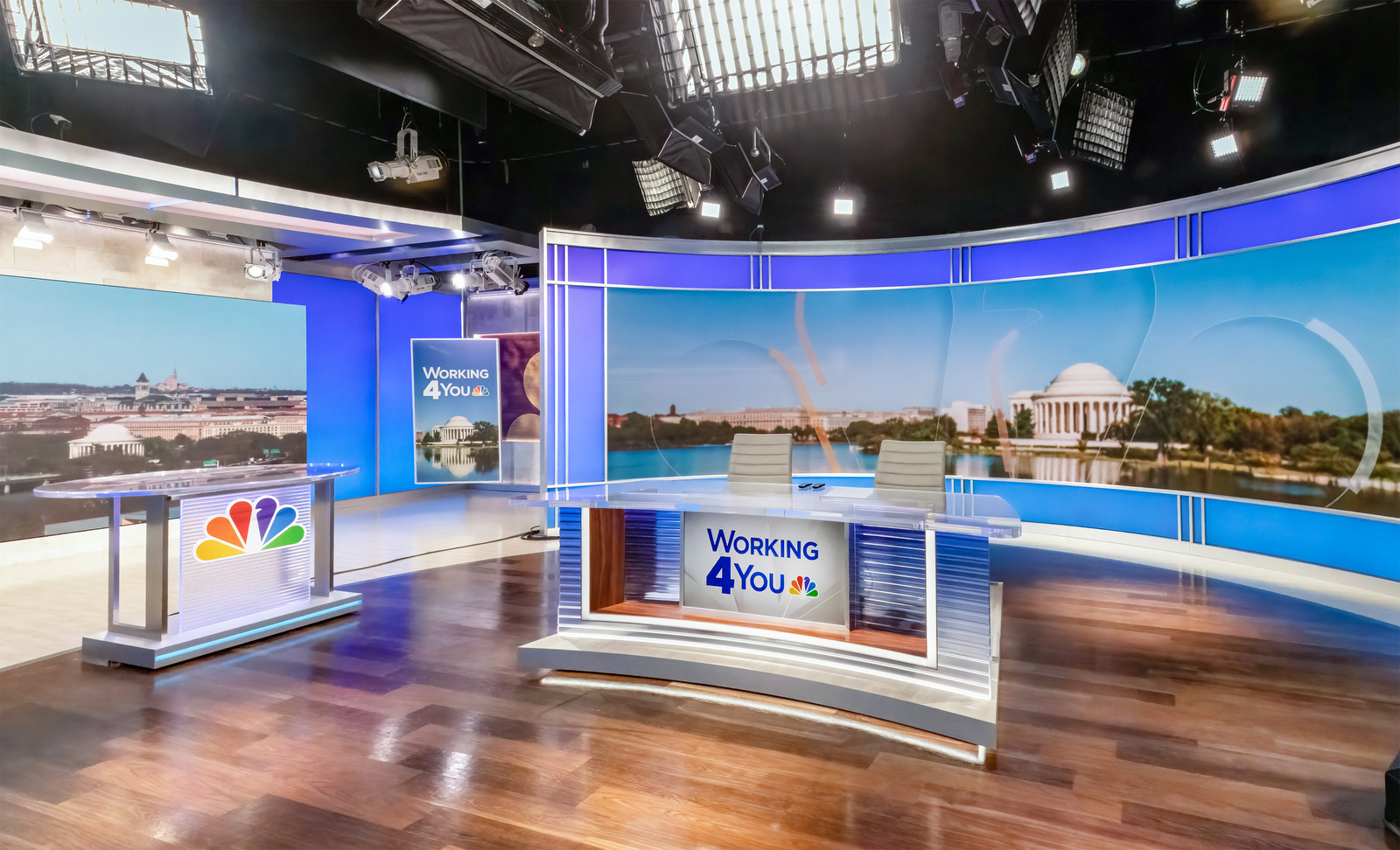
Subscribe to NCS for the latest news, project case studies and product announcements in broadcast technology, creative design and engineering delivered to your inbox.
Originally built in 1958, the Nebraska Avenue home of WRC, the NBC-owned station in the Washington, D.C., market is packed with history.
Names such as David Brinkley and Tim Russert have strolled down the halls and one of the pivotal Kennedy-Nixon debates took place within.
These days, the building is full of contractors and construction as WRC and Telemundo sister station WZDC work to transform it into an updated broadcast facility devoted to local television.
For years, WRC’s local newscasts originated from Studio B.
“While it was home for us, it was definitely time for a change,” said Mike Goldrick, the station’s vice president of news in an interview with NewscastStudio.
As it happened, WRC had a very large space to fill.
The story behind that actually starts years ago — before the words “COVID-19,” “PPE” and “social distancing” had entered most people’s vocabulary.
In the years leading up to 2019, NBCUniversal had been debating what to do with the Nebraska Avenue building that WRC and the high-profile NBC News Washington bureau had occupied since it opened.
The building was outdated and in need of some key infrastructure updates, but it had also served both the station and network well over the years.
Ultimately, NBC News decided to move out, headed for an expanded presence at 400 North Capitol Street NW, inside a building where it already had some small studios overlooking the Capitol Rotunda as well as workspaces strategically located near the center of power.
Most correspondents in the region still worked out of Nebraska Avenue before the move, many of them with offices along the so-called “Correspondents Row,” a row of workspaces that some of the biggest names in NBC’s history in D.C. have occupied.
The building also had two separate newsrooms, one that served network needs and one that fueled the local NBC newscasts as well as, later, Telemundo 44.
The main network newsroom would go on to become a familiar sight to NBC viewers, appearing on “Today,” “NBC Nightly News” and other productions as the background behind D.C. correspondents’ live shots.
The WRC building also had a large studio, Studio A, that was home to “Meet the Press,” the network’s historically long-running Sunday morning public affairs program.
It turns out that space was at the core of transforming the building.
Upgraded studios and a future newsroom
The 5,870-square foot studio was subdivided into four spaces — two identical ones with one for WRC and one for WZDC and then two smaller ones.
NBC Sports Washington is also operating out of the building and it was a significant part of its planning. However, NBC sold it recently to Monumental Sports & Entertainment and the network will eventually move out — with a rebranding slated for late this year.
Now, the stations are left with two spaces that will likely end up as multifunctional spaces servicing its digital, OTT, streaming and other production needs. New designators have not been assigned to the sub-divided spaces yet.
The old WRC studio, meanwhile, will eventually be emptied out. NBC doesn’t have any immediate plans for it, but may end up renting it out thanks to an increased demand for studio space in the district.
Meanwhile, it’s not just the studios that moved. WRC is in the process of building a new newsroom in the rear of the building where part of the old bureau space was.
During renovations, staffers are still working out of part of the original newsroom near the front but NBC is working on a master plan with architect Gensler to create dynamic new workspaces.
Eventually, the main WRC newsroom will feature an open atrium-style design with updated workstations.
The project will eventually include a total of four new control rooms as well.
Construction is still expected to go on for a bit, so staff is looking forward to moving into the final product, which has gotten great support from NBCUniversal Local chair Valari Dobson Staab, Jeff Morris, executive vice president of technology and operation, Glenn Thomson, vice president of technology and operations, Richard Clinton, vice president of construction and Fernando Pa, vice president of master planning and design.
WRC’s vice president and technology and operations Alan Helfand has also been instrumental with the project.
The station also made the somewhat tough decision to tear down part of the building — Correspondents Row — in order to make space for much-needed parking. While its offices were full of memories, its position and layout limited what it could be used for.
The new home of NBC Washington
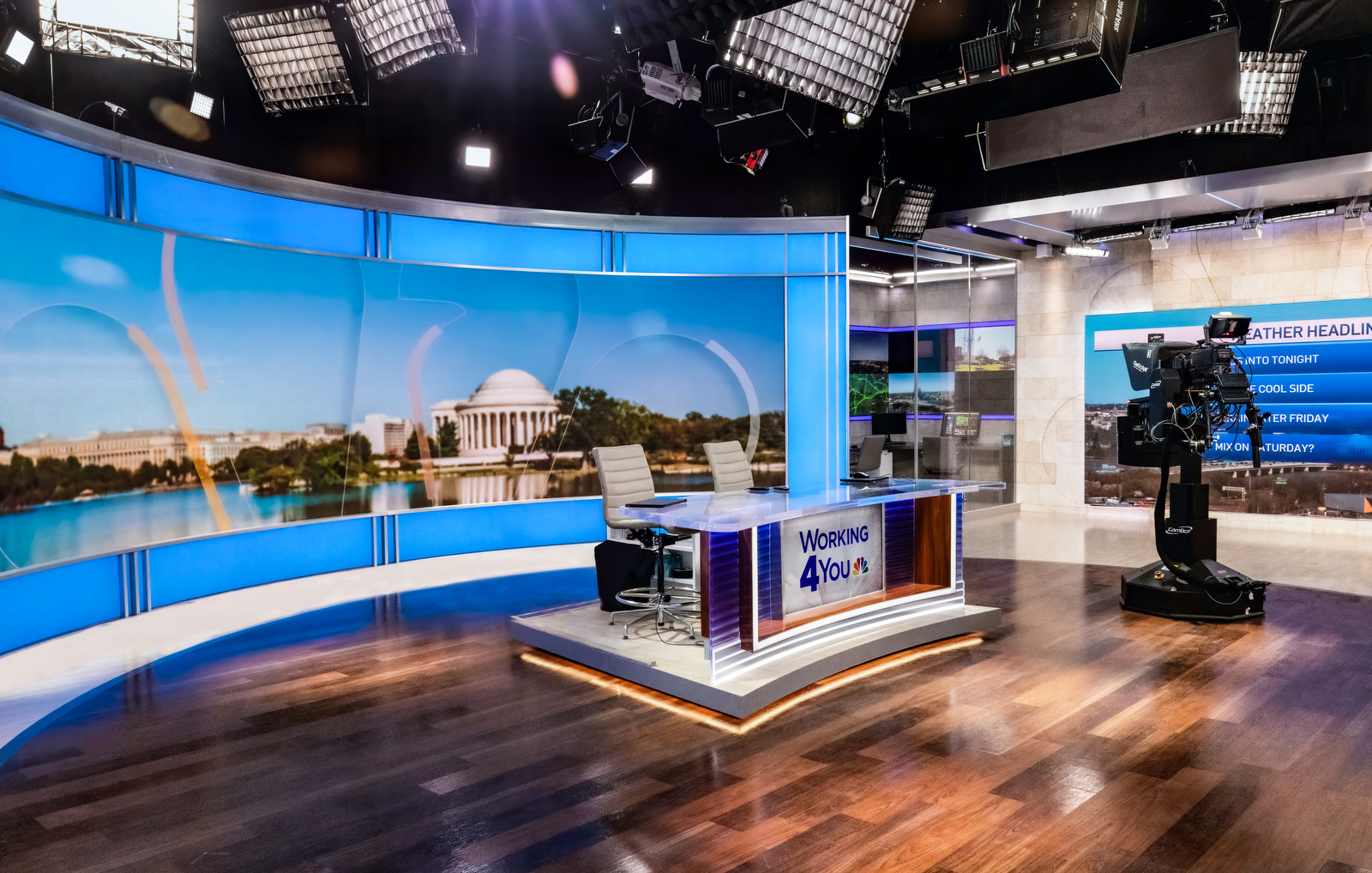
Inside a part of former Studio A, WRC and Jack Morton Worldwide’s Andre Durette designed a fresh look for its local news.
Therese Gamba, NBCU’s senior vice president of marketing and acquired programming, helped guide the station through the design process.
Much of the design has hints of other recent NBC-owned stations debuts but with D.C. flair and subtle references to neoclassic design. The look is “blended into a contemporary 21st-century aesthetic capturing a timeless style, enabling NBC4 and Telemundo 44 to grow into the future,” said Jack Morton in its description of the project.
The spatial concept of circles intersected by diagonals is also woven throughout the design.
The design team brought in faux marble and stone finishes as a nod to the monument-heavy city. There’s also a layered map of the Washington, D.C. street grid, an element similar to one found over on North Capitol’s Studio N1.
In addition to multiple seamless video walls, a hallmark of so many news sets these days, there are also references to the repeating lines in classic monument architecture in some of the space’s backlit panels and metallic framework as well as rippled glass panels.
Jack Morton worked with Blackwalnut to handle building the walls of the spaces, while Mystic Scenic Studios took charge of building the desks.
Much of WRC’s space is inspired by symmetry, a concept culled from classic architecture, as well as circles.
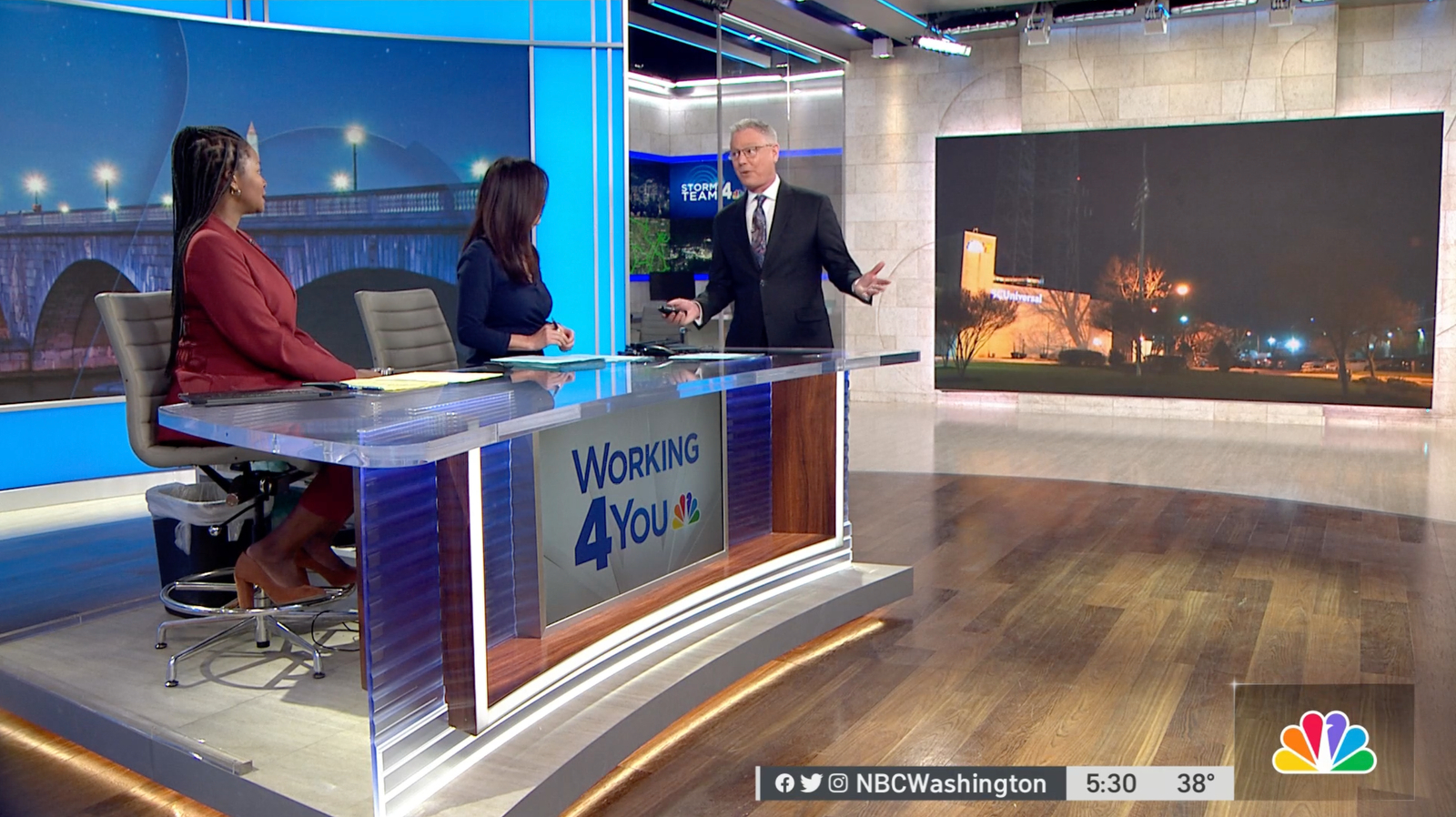
The station also added an in-studio weather center, something it didn’t have before. This will allow closer interaction with forecasters and anchors and emphasizes its commitment to weather coverage.
In WRC’s studio, the weather center is tucked into a corner semi-separated from rest of the space with a glass panel. Behind this, workstations feature a stack of drawers that, ironically, have the feel of heavy blocks of stone.
Nearby is an entire alcove in a light stone finish with a seamless video wall and pivoting traditional panel.
There’s also an oversized NBC peacock outline carved into the wall, as well as one created using varied wood tones.
Opposite this is another video wall set into a backlit wall with a faux limestone-like surface that wraps from the upper portion of the scenery, down the wall and spreading onto the floor, a nod to the walls, frieze and base components of classic architecture.
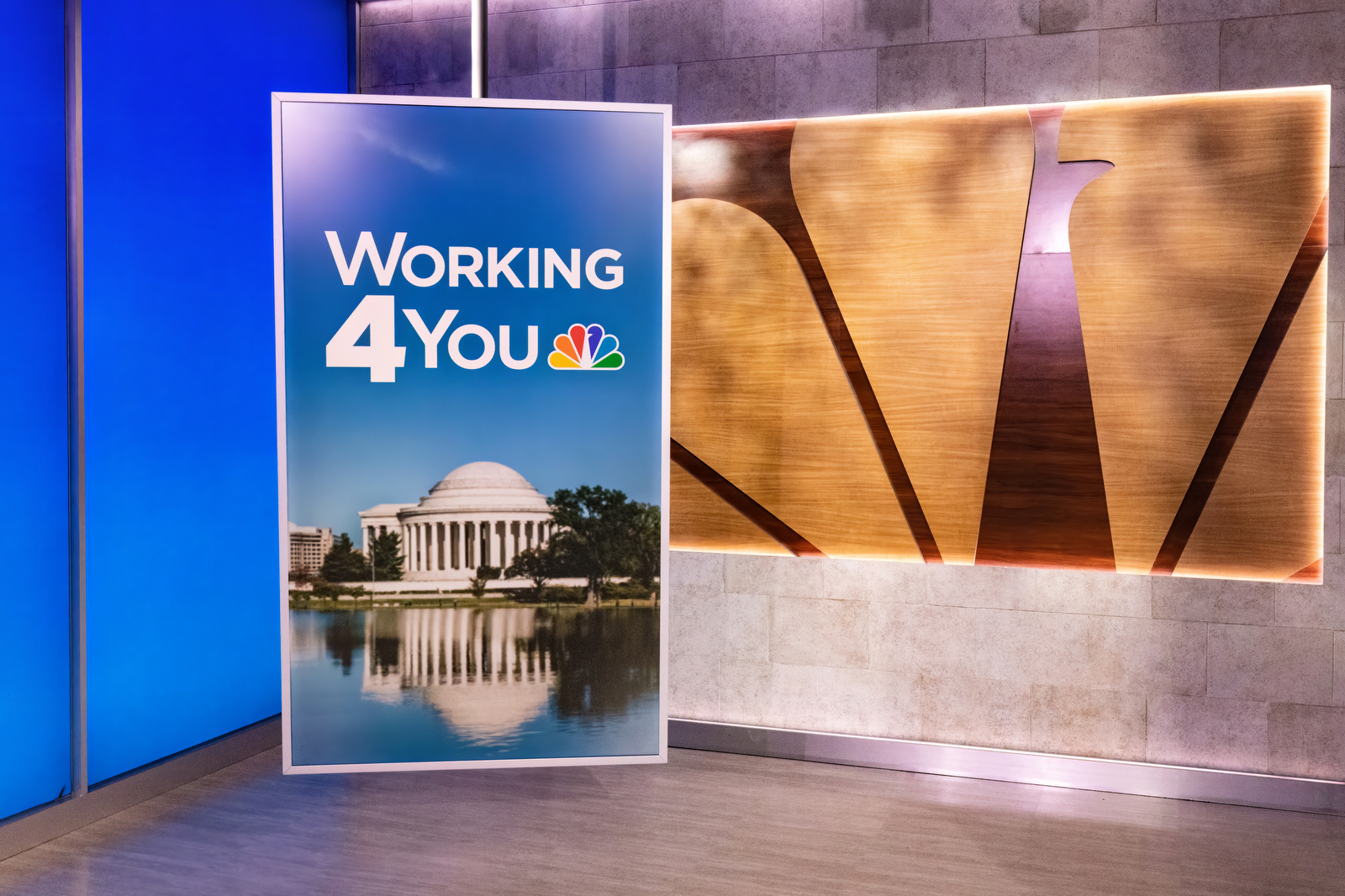
Goldrick also notes that the station worked closely with the team at ArtHouse, the network’s graphics hub in Dallas, Texas, to bring in other Washington, D.C.-inspired looks for the other video wall arrays installed throughout the space.
To add more elements from the district, NBC is working on creating a network of 4K cameras scattered throughout the city capturing live images of some of the capital’s most iconic landmarks that can be fed to the numerous video walls, Goldrick said.
Telemundo 44 expands its Washington footprint
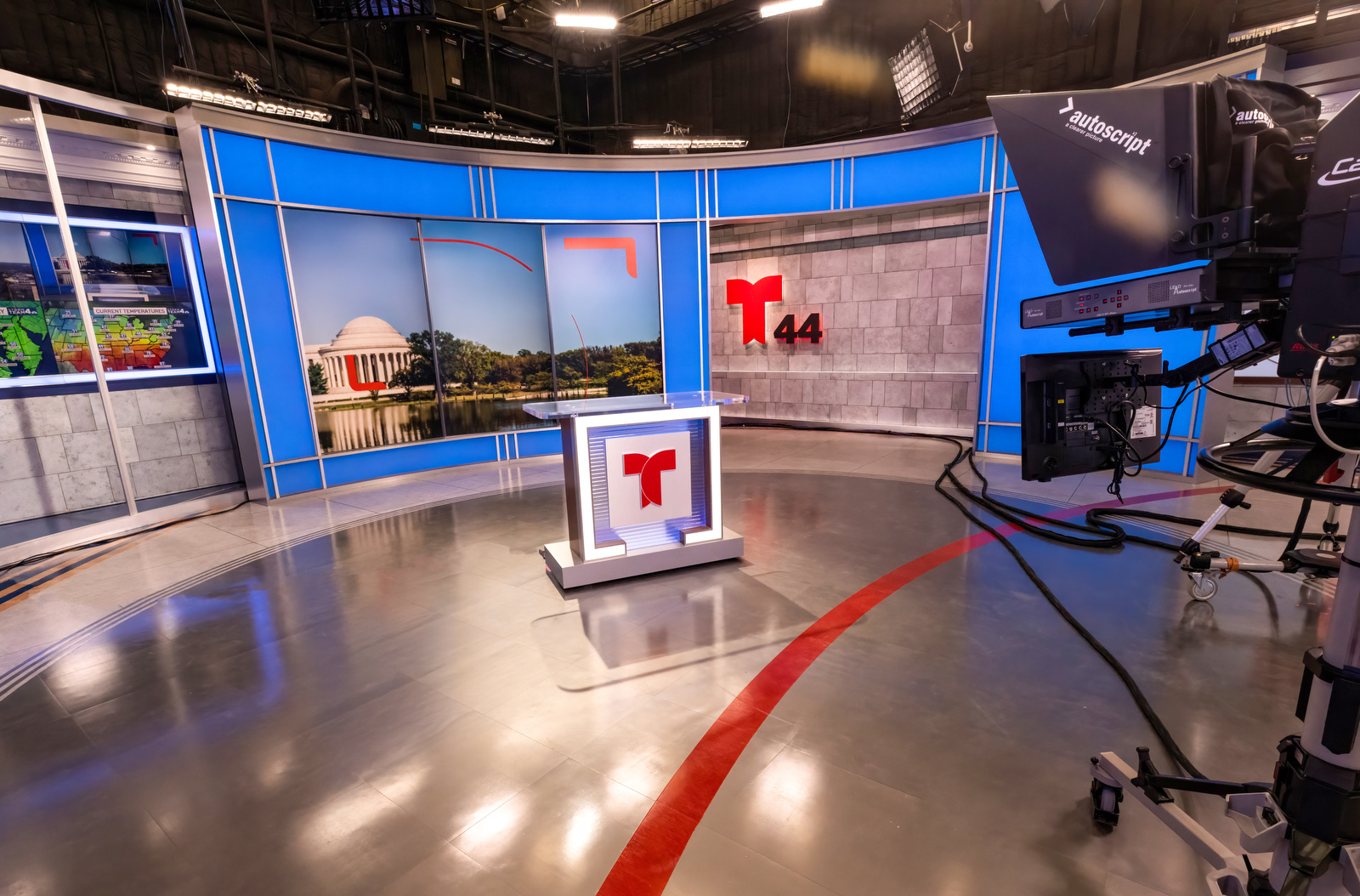
Over on the Telemundo 44 set, Jack Morton used a more elliptical, oval and asymmetrical theme for a slightly more non-traditional feel. The geometry also happens to share a name with the curved patch of lawn called the Ellipse located south of the White House.
Including a large ribbon of curved LED that stretches across the background behind the main anchor desk.
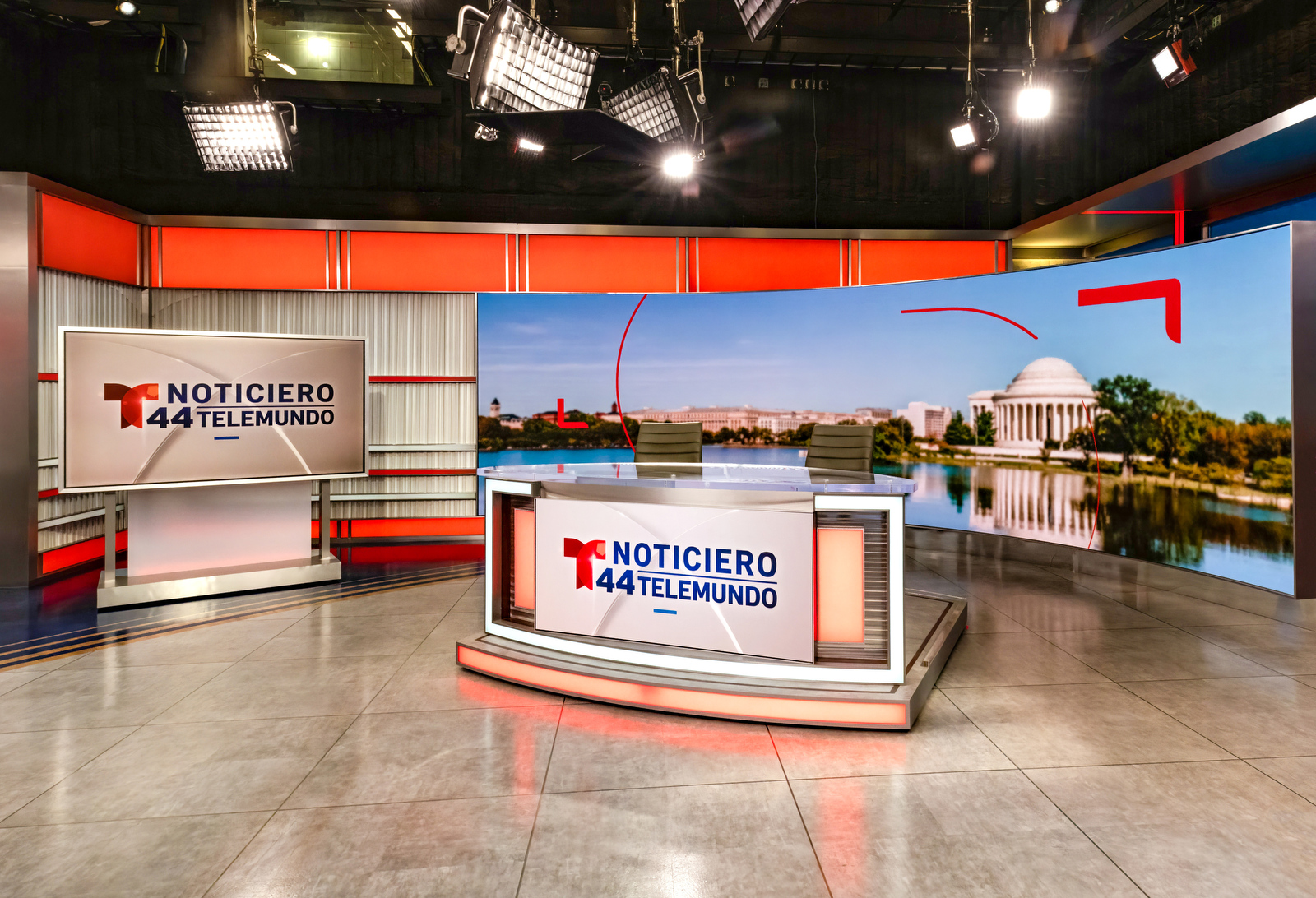
This array contrasts with the rectangular wall behind it which makes a 90-degree turn to create a corner for a mobile video cart.
Telemundo 44 also got an in-studio weather center, plus additional standup-style venues equipped with LED video displays, including an array that can be separated into three segments thanks to a track and pivot mechanisms.
Behind these a wall of faux stone and backlit panels with metallic frames that drive home the interior curves in the Telemundo “T” logo, along with the full color version of the logo repeating across.
That “rule of three” theme carries through in the largest panels of the glass divider in the weather space as well as three vertically-mounted panels installed in a backlit curved wall to create a window-like look that also includes an opening that reveals a faux stone alcove with bold red “T” mounted on it.
Prior to the move, WZDC broadcast its newscasts from a room that was a “former ‘a lot of things’,” as Goldrick jokingly labeled it.
It was a rather small, cramped space that wasn’t originally intended for broadcast and ultimately was only meant to be temporary — but five years ended up passing by. “They’ve been very patient,” Goldrick said.
Telemundo’s space has similar thematic elements as WRC’s set. The station has a forecaster, Joseph Martinez, who has carved out a niche with AR weather explainers, so extra attention was given to designing a venue that had floor space for his digital creations to “sit” on.
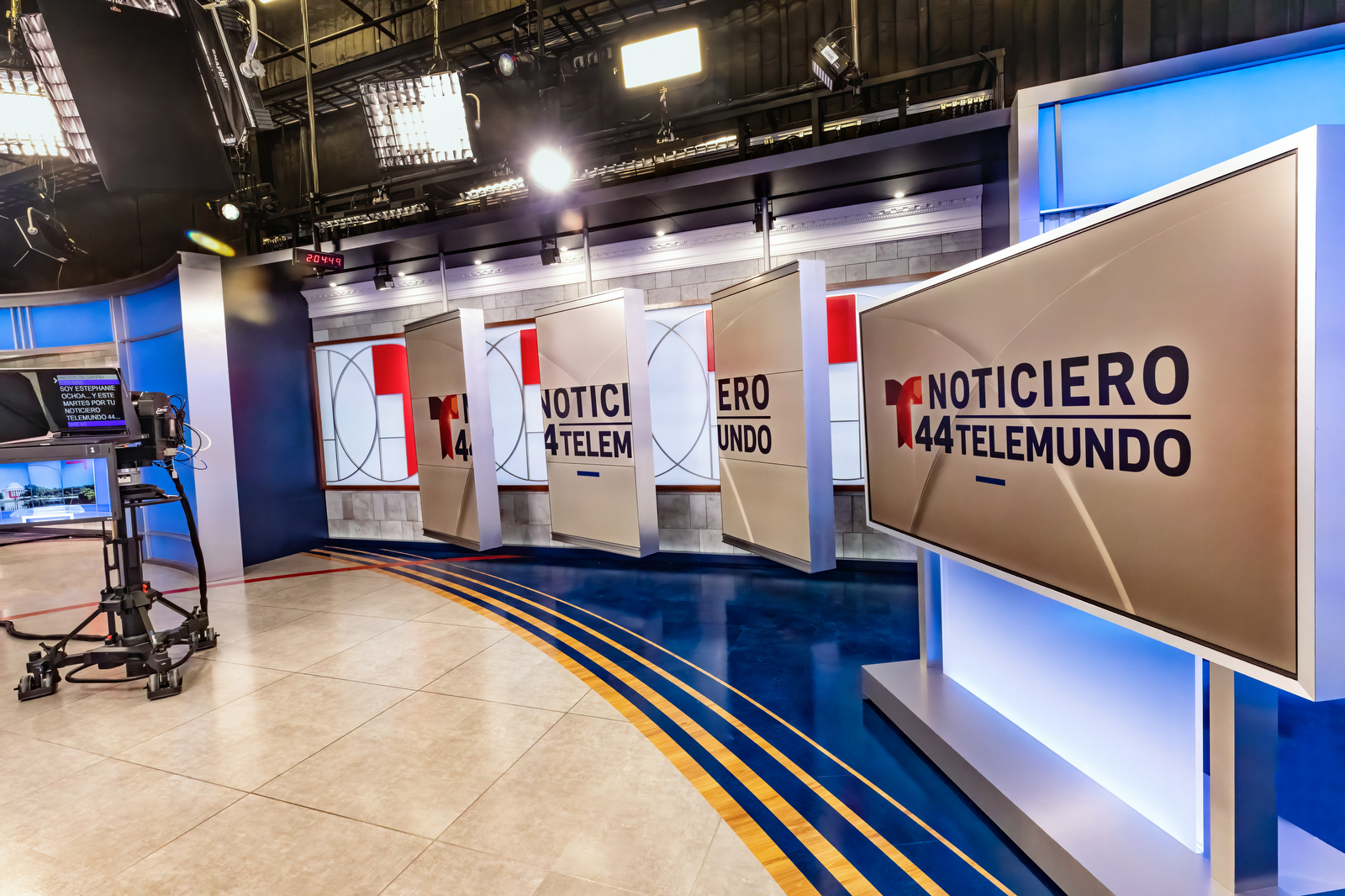
Right now, the station uses The Weather Company’s built-in AR solution, but is also exploring all its options for bringing AR to both news and weather on both stations.
While both sets have their distinct looks, there is also a shared language between the two while also offering the flexibility for production, demonstration and interview setups in both spaces.
In fact, there are two desks that can be used in either space, complete with panels that let crew pop out the NBC peacock in exchange for the Telemundo logo as needed.
Both studios can use stylized photographic backgrounds with logo elements mixed in to create on-brand and local imagery, much of it created by the team at NBC’s creative hub.
ArtHouse also has, like it does for all NBC-owned stations it services, collaborated closely with the station to create templates and standards so that if a graphic is requested for a specific video wall, the hub designers known that, for example, an anchor will be standing in this part of the screen so it wouldn’t be wise to put text there.
Goldrick praised Joel Michon, vice president of creative at ArtHouse as well as Tracee Cummins, the vice president of operations there, for their work on the project.
Overall, the set upgrade was a big move for both WRC and WZDC, a change that wouldn’t have been possible if not for the overarching strategic plan for the entire building.
“Everybody loves the new studios. The new lighting is so clean, so crisp and so fresh. It feels like we jumped into the 21st century, said Goldrick.
Despite all the literal moving parts in the overall building project, which is still yet to be finished, working with multiple vendors and contractors has been well-coordinated.
“The whole process has gone so well thanks to our partners,” said Goldrick, noting the team from Gensler and Jack Morton in addition to AV integrator GCI and The Lighting Design Group.
Project credits
Scenic Design by Jack Morton Worldwide
- Production Designer: Andre Durette
- Designer: Amr Abdelfattah
- Design Support: Evan Hill, Larry Hartman
- Project Management: Meredith Sonnen, Matt Jackson
- Illustration: Chris Maroney, Erik Nevala Lee, Jennilee Aromando
- Graphic Design: Raeford Dwyer, Shelline Vandermey, Joon Choi
- Drafting: Graham Caufield, Derek Van Heel, Nick Nocera
For WRC-WZDC
- Production Manager: Dante Wilson
Fabrication by Blackwalnut
- Project Manager: Christin Donato
Fabrication by Mystic Scenic Studios
- Project Manager: Ben Jacobson
AV Integration by GCI
- AV integration: Dave Hulings, Andrew Gerner
Lighting Design by The Lighting Design Group
- Niel Galen, Senior Lighting Designer
- Evan Cope, Gaffer
- Tim Ruppen, Programmer
- David Cook, Project Manager
- Declan Moore, Lighting Director
Lighting gear includes
- ETC EOS processors and console
- Cineo Light Blades, LB800, Standard 410 and Mav X
- Chauvet Ovation Reve E3 profiles and Colorado 3 Solo PARs
Studio Robotics from Ross Video
Correction: An earlier version of this story mis-credited one executive and contained an incomplete summary of those involved in the project. It also incorrectly described the history of NBC Sports Washington. The article has been updated.
Subscribe to NCS for the latest news, project case studies and product announcements in broadcast technology, creative design and engineering delivered to your inbox.






tags
Andre Durette, Blackwalnut, Gensler, Gensler Architecture, Jack Morton, Jack Morton Worldwide, Mystic Scenic Studios, NBC Arthouse, nbc washington, Washington, D.C., wrc, WZDC
categories
Broadcast Facility, Heroes, News Set Design, Set Design